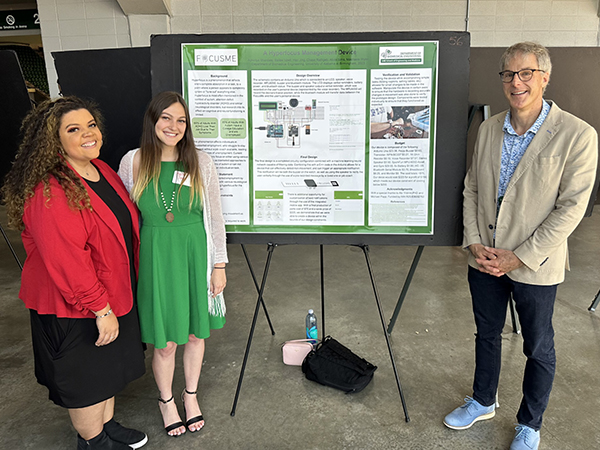When Bailee Isbell and Alivia Sims enrolled at the UAB School of Engineering, they knew they would be in a minority in a field that historically enrolls more men than women. But they had no idea they would become pioneers.
This weekend, the trailblazing duo will become the first two graduates of UAB’s Bachelor’s in Engineering Design program. The program, started in 2019, allows students flexibility to adjust the engineering curriculum to their own interests with a heavy focus on hands-on design and innovation, as well as a minor in one of the existing engineering disciplines.
Isbell and Sims both say they chose Engineering Design because they wanted the freedom to explore the curriculum in a new way. “Early on in my first program, it seemed like some of the classes weren’t geared toward what I wanted to do,” Isbell said. “I thought this new path would allow me to customize my studies to what suited me.”
“We started in BME,” added Sims, “and I realized early on that I wanted to tackle bigger projects that I could work on from start to finish—as opposed to focusing on one specific part of a process or a larger project. I think Bailee and I both liked the hands-on component and being able to choose our focus while using the minor to get additional training and experience.”
Switching majors typically requires some adjustments, but in a major designed to add flexibility, both students say program director Tim Wick, Ph.D. took care to structure the courses in a way that allowed students to adapt. “We came in understanding that there would be some hiccups, just because it was all new. But Dr. Wick made a point to solicit feedback and to listen to what we were interested in and what we wanted to learn,” Isbell said. “I’d never been asked for that kind of input from a professor before.”
“He made sure we were getting what we needed from the program,” said Sims.
Historically, all UAB engineering students have had to complete a senior design project before graduation. The project typically involves working in teams to build working prototypes to solve real workplace challenges.
In Engineering Design, however, Isbell and Sims tackled similar design challenges each semester, applying lessons from each challenge and building on that knowledge for each successive project. “We were genuinely solving problems,” Isbell said. Sims added, “We would build a prototype, and that might lead to a more advanced prototype, and so on. I think sometimes in class, you don’t see how the classwork connects to anything practical, but in these projects, you could see where the things we were learning could be applied to projects.”
Practical issues aside, Isbell said working with real-world clients helped her develop something that some scientists and engineers might lack—empathy. “We had to be able to see each device or process from the client’s perspective,” she said. “Sometimes it’s easy to get caught up in the engineering process. You may come up with a brilliant design that is useless when you put it in the hands of the actual user.”
Having worked through that process so many times served the student well this past year when it came to fulfilling their senior design requirement. They were both part of a six-person biomedical engineering team that designed a hyperfocus tracking and alert system to aid people with autism, ADHD, or similar neurological disorders to be more productive in the workplace for the purpose of job retention.
With that project now completed, the two plan to pursue different paths. Sims plans to enter the workforce and relocate to Huntsville, while Isbell will enter the workforce and enroll in UAB’s biotechnology graduate school program. However, both will be entering a career in prosthetic design.
No matter what the future holds, they both agree that the legacy they leave behind as pioneers in Engineering Design is something they will always be proud of. “I think we’re more excited about being the first graduates of this program than in actually graduating college,” Isbell said.
“In most of our regular engineering classes, there were no more than 10 female students, and sometimes only two or three,” Sims said. “To say we’re the first two graduates—not just the first female graduates but the first graduates, period—is pretty cool.”
